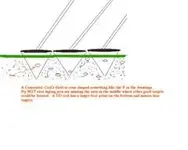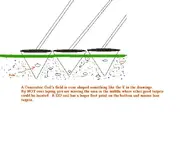SandMan has the right idea. There is something else I'd like to share with you all though;
Jack Gifford of Tesoro Electronics says that the iron mineralization in the ground makes it absolutey necessary that we operate our detectors 2" off the ground at a constant and even level, if we want maximum depth from our detectors. I.E. 1" of grass plus 1" of air. . It's because there is a null point that our detectors operate on, one that performs best when we aren't fighting the automatic null level created by our detectors in relationship to the ground (matrix), a "package deal" viewed by our detectors. A matrix is the combined and total material that we hunt in, be it water, soil, coke, granite, etc. The detector does not view it as a lot of different thngs in the ground, but it does view it as #1 the dominant mass (matrix), and #2 the anomaly (the target). When a detector "sees" a target, it automatically determines the electroconductivity of the matter, and this is why some detectors discriminate better than others, such as Tesoros. It's because the detector recognizes that one metal or substance is more or less electrically conductive than another. Analog meters show us this and so do digital meters on DFX's and Explorers. Compasses and Tesoros do this the best, and usually are the ones that when placing a piece of steel on the ground and cancelling it, and then putting a nickel right on top of it, it will give a clear and absolute signal. These two detectors do this the best of the best, and it's because of the superior combined extremely fast auto-retune/auto-threshold to null relationship built into them.
Compass Electronics invented auto-retune and auto threshold, plus DD coils too, and without them we would still have a lot of problems with bad ground.
Now this optimum search height should be obeyed almost religiously according to George Payne, if you have many minerals in your search ground. He talks about it in his notes on the Millinium, Baron, etc. He claims that the more mineralization that's in the ground the more we should tend to the optimun, perfect, 2" search height.
I had a lot of trouble believing this when I first read it, but after awhile it does makes a bit of sense to me. It is the same as viewing a sine wave on a scope. The "null" operates from +1/2" positive to -1/2" negative as with Compasses and Tesoros, or up to +3" positive and -3" negative with other machines like Garretts, Minelabs etc. This is the VERY reason why (most) Minelabs have to be run so slow, it's because they DO run so slow in returng to the auto-null. It is necessary because of so many electronic calculations regarding mass, signal strength, voltage, built into highly analizing detectors such as Explorers, Coinstrikes, and DFX's.
In the sine wave there are the upper (+) parts of the wave (positive voltage) with an imaginary line drawn between them and the lower waves exactly in the middle of +/-. it looks like a snake going up and down and forward (or backward) as the case may be. And then there are the lower parts of the wave (-) negative voltage. If we operate our detectors too close to the ground then we drive and PUSH our detectors into the positive and it can easily create a lot of positive and unnecessary noise coming from our detector. In any bad soil by doing this we would be defeating our desire to get the optimum performance from our detector, or, in other words, we would be losing our depth potential and at times even losing good targets too, especially if we go too fast.. In air it wouldn't matter much at all though, and in very lightly mineralized soil it wouldn't matter as much.
People first began "scrubbing" their coils because TR's (transmit/recieve) detectors did not operate the same as the BFO's and VLF's. TR's sent a signal that was returned much like a pair of walkie-talkies send back and forth, but VLF's and BFO's, etc read "disturbed" fields, not signals coming back to the receivers, a totally different concept, and one that is not dependent on optimum performance coming from maintaining a certain height. Only a threshold was important with a TR. BFO's had a much different problem though and it involves writing scrolls to explain that situation. TR's though, were dramatically affected by iron mineralization to the max, because we had to maintain our null ourselves, rather than the detector helping us along with it.
HH
EasyMoney





 1 way signals
1 way signals

 .........well at leat 90% with the machine at 5% and luck at 5%.
.........well at leat 90% with the machine at 5% and luck at 5%. 